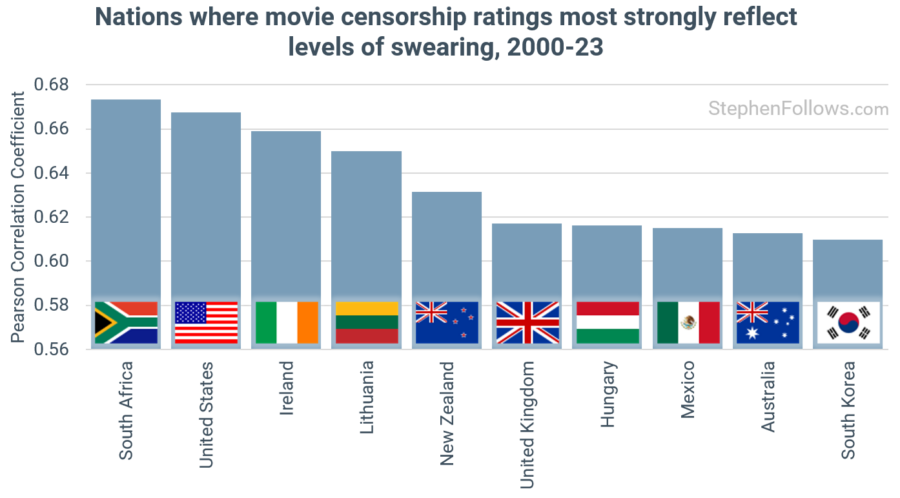Which countries are most offended by swearing in films?
In the past, I have explored various facets of swearing in films, such as which country produces the most expletive-laden movies, the prevalence of swear words in different genres and how swearing can actually help screenwriters get higher scores in script competitions (I mean swearing in the script, not in emails or real life).
Today we’re looking at the relationship between film censorship and swearing. I examined how censorship boards around the world respond to swearing in films.
Using a database of nearly 6,000 films released globally since 2000, I have analysed the ratings provided by 44 different countries for each film. By assigning a value to each rating and correlating these values with the level of swearing in each film, I’ve identified which countries are the most concerned with bad language on-screen.
To measure this, I used the Pearson correlation coefficient, which ranges from -1 to 1. A value of 1 indicates a perfect positive correlation, meaning that as the level of swearing increases, the severity of the film’s rating also increases proportionally. A value of 0 suggests no correlation, implying that the level of swearing has no effect on the film’s rating.
The results reveal regional patterns and provide fascinating insights into cultural attitudes around the world.
The nations most concerned about swearing
South Africa and the United States emerged as the countries most sensitive to swearing in films. Both exhibit a striking Pearson correlation coefficient of 0.67 between the severity of their film ratings and the presence of swear words. This suggests that the more swearing a film contains, the more likely it is to receive a stringent rating from their respective censorship boards.
Ireland follows closely with a correlation of 0.66. Given Ireland’s high frequency of swearing in the films it produces, it’s intriguing to see that Irish censors are also highly attuned to bad language when it comes to rating films.
It’s interesting to observe that there is a mix of Anglophone and non-Anglophone countries among those most concerned with swearing. Australia (0.61), South Korea (0.61), and Hong Kong (0.60) further illustrate a global diversity in the prioritisation of language purity in films.
Who’s not all that bothered about f’ing swearing?
On the other end of the spectrum, Italy is the least sensitive to swearing in films, with a Pearson correlation coefficient of just 0.32. This suggests that Italian censorship bodies are relatively lenient when it comes to bad language, assigning less severe ratings regardless of the amount of swearing in a movie.
France (0.37) and Sweden (0.41) also appear to adopt a more relaxed approach to profanity in films. Close behind is Denmark with a correlation of 0.43, followed by the Netherlands (0.45), and the UAE (0.46).
Swearing all over the place
When we take a step back to look at the global landscape, certain regional trends become apparent. English-speaking countries such as South Africa, the United States, Ireland, New Zealand, and the United Kingdom exhibit some of the highest correlations between swearing and film ratings.
However, within this group, there are notable distinctions. While the US and UK share a strong cultural and linguistic heritage, their censorship patterns still show unique differences. The US tends to be slightly stricter, reflecting perhaps the diverse and larger audience it caters to, which includes more conservative segments.
Notes
Today’s research examined 5,918 feature films released between 2000 and 2023. The dataset includes ratings from 44 different countries, ensuring that each country had at least 1,000 film ratings.
To analyse censorship sensitivity to swearing, I assigned a value to each rating, with the most open rating (typically “Universal” or “General”) receiving a one and increasing values assigned to more restrictive ratings (e.g., in the UK, an 18 certificate equated to a value of five). This allowed me to calculate the Pearson coefficient to measure the correlation between the rating level and the presence of swearing in each film.
The swearing data was collated from a range of sources, including OMDb, IMDb, Common Sense Media, Dove.org, and direct information from ratings bodies. This comprehensive approach ensured a robust measure of the extent of swearing in each film.
It’s important to note that films might have different versions around the world. The swearing measures tracked were based on the English-language versions released in the UK and US, which rarely differ significantly. However, in certain territories, specific words or phrases might be censored or altered. Despite this, the overall profane content remains relatively consistent, and any such minor alterations are unlikely to significantly affect the overall correlation analysis.
The post Which countries are most offended by swearing in films? appeared first on Stephen Follows.





